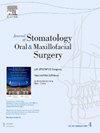利用深度学习在 CBCT 图像上检测囊性病变的人工智能机制。
IF 1.8
3区 医学
Q2 DENTISTRY, ORAL SURGERY & MEDICINE
Journal of Stomatology Oral and Maxillofacial Surgery
Pub Date : 2024-11-17
DOI:10.1016/j.jormas.2024.102152
引用次数: 0
摘要
导言本研究旨在提供并评估人工智能机制在锥形束计算机断层扫描(CBCT)中检测囊性病变的效率:CBCT 图像数据集由 150 个样本组成,包括 50 个无病变病例、50 个齿槽囊肿 (DC) 和 50 个根尖周囊肿 (PC)。数据集分为开发集和最终测试集,前者有 70% 的样本用于训练和验证,后者有 30% 的样本用于训练和验证。每个病例获得四幅图像,包括全景图像、手动分割的全景图像、轴向图像和手动分割的轴向图像。深度卷积神经网络(CNN)架构用于自动检测病变和诊断囊性病变的类型。为了增加图像样本的数量并避免过度拟合,采用了数据增强程序。对病变检测性能的召回率、精确度、F1-分数和平均精确度(AP)值进行了测量,对 CNN 模型的病变分类性能的灵敏度、特异度和准确度指标的混淆矩阵进行了计算:结果:数据增强前,DC 和 PC 检测的平均精确度、召回率和 F1 分数分别为 0.87、0.92 和 0.89,增强后分别为 0.93、0.95 和 0.93。对于经过数据增强的 DC 分类,灵敏度、特异性、准确性和 AUC 值分别为 96.4%、99.5%、97.3% 和 0.98,而对于经过增强的 PC,这些值分别为 89.6%、98.9%、98.1% 和 0.94。最后,对于无病变样本,应用数据增强后的灵敏度、特异性、准确性和AUC值分别为100%、99.1%、99.4%和0.99:我们开发的基于深度学习的 CNN 算法在使用数据增强技术检测 CBCT 图像上的齿状囊肿和根尖周囊肿并对其进行分类方面表现出了较高的准确性、灵敏度和精确度(超过 90%)。本文章由计算机程序翻译,如有差异,请以英文原文为准。
An artificial intelligence mechanism for detecting cystic lesions on CBCT images using deep learning
Introduction
The present study aimed to provide and evaluate the efficiency of an artificial intelligence mechanism for detecting cystic lesions on cone beam computed tomography (CBCT) scans.
Method and materials
The CBCT image dataset consisted of 150 samples, including 50 cases without lesions, 50 dentigerous cysts (DC), and 50 periapical cysts (PC) based on both radiographic and histopathological diagnosis. The dataset was divided into a development set with 70 % of samples for training and validation and a final test set with the other 30 % of samples. Four images were obtained for each case, including panoramic, manually segmented panoramic, axial, and manually segmented axial images. A deep convolutional neural network (CNN) architecture was used for automatic lesion detection and diagnosing the type of cystic lesion. To increase the number of image samples and avoid overfitting, a data augmentation procedure was applied. Recall, precision, F1-score, and average precision (AP) values were measured for lesion detection performance, and sensitivity, specificity, and accuracy indicators from the confusion matrix were calculated for the lesion classification performance of the CNN model.
Results
Mean average precision, recall, and F1-score for the detection of DCs and PCs were respectively, 0.87, 0.92, and 0.89 before data augmentation, and 0.93, 0.95, and 0.93, after the augmentation process. For the classification of DCs with data augmentation, sensitivity, specificity, accuracy, and AUC values were 96.4 %, 99.5 %, 97.3 %, and 0.98, respectively, and for PCs with augmentation, these values were 89.6 %, 98.9 %, 98.1 %, and 0.94, respectively. Lastly, for no lesion samples, sensitivity, specificity, accuracy, and AUC values were 100 %, 99.1 %, 99.4 %, and 0.99, respectively, by application of data augmentation.
Conclusion
Our developed deep learning-based CNN algorithm showed high accuracy, sensitivity, and precision values (more than 90 %) for detecting and classifying dentigerous and periapical cysts on CBCT images using data augmentation.
求助全文
通过发布文献求助,成功后即可免费获取论文全文。
去求助
来源期刊

Journal of Stomatology Oral and Maxillofacial Surgery
Surgery, Dentistry, Oral Surgery and Medicine, Otorhinolaryngology and Facial Plastic Surgery
CiteScore
2.30
自引率
9.10%
发文量
0
审稿时长
23 days
 求助内容:
求助内容: 应助结果提醒方式:
应助结果提醒方式:


